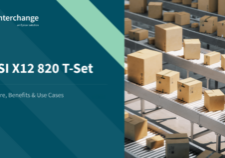In-house vs Managed Service EDI
Which One is Right For You?
Its ability to digitise and simplify the exchange of computer-to-computer electronic documents in real-time has led to the adoption of electronic data interchange (EDI) by as many as 85% of companies, including top names like Amazon.1
Even as global processes and operations increase in complexity across markets, EDI’s power remains relevant and increasingly necessary to a wide range of sectors, such as:
- Automotive
- Logistics
- Manufacturing
- Retail
- Healthcare
For companies looking to gain the full benefits of EDI implementation, effective deployment is essential. While in-house solutions have traditionally been the most logical go-to for businesses, managed services are growing in popularity due to their ease and efficiency.
In this article, we consider both approaches in detail and determine which solution is best for your business. Let’s get started.
Suggested reading: To learn about how you could gain a competitive edge with the help of an EDI solution, take a look at our free eBook — The Supply Chain Centred Business
What is EDI and why is it important?
The history of EDI goes back to the 1960s when Ed Guilbert developed it as a standardised system to allow tracking of cargo via telex, radio, teletype, and telephone. However, EDI didn’t gain widespread acknowledgement until the 90s, when companies realised the value of a methodology that enabled the free flow of critical business documents.
Using a set of best practices, standards, and processes that enable crucial business documents to be exchanged electronitcally, EDI has been removing the need for complex and paper-based processes ever since. This has led to the significant simplification of documentation exchanges, including purchasing orders, customs documents, invoices, and beyond.
As well as improved supplier relationships and efficient processes, EDI has been able to provide businesses with a range of benefits over the last few decades, including:
- Increased visibility: The full end-to-end transparency of ordering processes for businesses and their trade partners enables improved relationships as well as informed decisions that facilitate service improvements.
- Reduced human errors: The removal of manual inputs significantly reduces the risk of human errors, which can lead to misunderstandings, order delays, and other unnecessary setbacks.
- Increased speed: The automated flow of communications shared in real-time eliminates the need to re-enter information or wait for delivery times, and ensures much faster processes and outcomes.
- Improved efficiency: Faster, automated processes increase supply chain efficiency while freeing teams to focus on other areas of complex trade, like acquisitions and relationship management.
Like any process, EDI has evolved, with legacy solutions becoming less effective and in some instances even obsolete due to the changing demands of global trade. That’s why businesses need to choose their EDI solution carefully. That means choosing between the two most common options for EDI deployment:
- In-house EDI: An EDI solution implemented, managed and maintained by an internal team of experts.
- Managed EDI: An EDI solution implemented and managed by a third-party provider without the need to purchase or deploy software company-wide.
Let’s take a look at both of these approaches in more detail.
In-house EDI
Companies looking to deploy EDI in-house must invest. Both in dedicated EDI infrastructure and in-house teams with the knowledge and expertise required to make the system run smoothly.
With this approach, all EDI processes are handled internally, including the implementation of the servers and machines necessary to ensure a comprehensive EDI solution. On top of that, teams need to be prepared to rapidly resolve issues and disruption in order to ensure business processes continue to run uninterrupted.
Benefits of in-house EDI
In-house EDI has been a go-to form of deployment since EDI’s rise to popularity in the 90s. While implementations of this kind have somewhat fallen out of favour in light of increasingly complex EDI requirements and global supply chain relationships, well handled in-house EDI can still provide businesses with a range of benefits, including:
- Freedom from reliance on a third party
- EDI professionals with a detailed understanding of company infrastructure
- Complete control over EDI processes and communications
- In-house handling of supplier relationships and reputation
- The ability to make immediate system changes
- Solutions tailored to unique requirements and trade partnerships
Costs of in-house EDI
Traditionally, the financial implications of in-house EDI deployment have been the largest downfall of this approach. As well as investing in EDI infrastructure, the need to employ dedicated teams of professionals has undeniably seen costs escalate as EDI’s capabilities evolve.
Furthermore, to be effective, in-house EDI must respond and adjust to market changes, which creates additional and often hidden costs, including:
- Maintenance, updates, and repairs
- EDI monitoring
- Ongoing licencing fees
- Evolving infrastructure including servers and technology
The often time-consuming handling of each of these considerations can also cost companies in efficiency by requiring resources that could be better utilised elsewhere. That said, when handled properly, the complete control over supply chain relationships that in-house solutions provide can help with supplier relationship management that ensures successful trade partnerships in the long run.
Managed service EDI
Managed service EDI is an outsourced deployment model in which a third party provider takes full responsibility for an organisations EDI implementation, maintenance and management.
When utilising this option, companies aren’t required to invest in any EDI infrastructure themselves, but are instead able to outsource these capabilities to companies already working within established EDI implementations, across already fully-trained teams of professionals.
Benefits of managed service EDI
The demands of modern-day supply chains have seen managed service EDI grow in popularity over recent years. That’s because fully managed solutions that ensure third party handling of all EDI components, including mapping, maintenance, and beyond, have provided ease and efficiency to companies that lack existing EDI expertise.
The ability to redistribute in-house resources as a result of managed EDI can also lead to opportunities for growth elsewhere, while further benefits of this option also include:
- Affordable access to dedicated EDI expertise
- Third-party handling of specific trade partner requirements
- Continual monitoring to reduce connectivity issues
- Reduced infrastructure investments
- Access to updated EDI technology
- Agile EDI implementations
- Improved trade partner responsiveness
Costs of managed service EDI
Affordability is one of the primary benefits of managed service EDI which traditionally operates on a subscription-based model. That said, managed service EDI isn’t guaranteed to be cost-effective, with poorly chosen providers posing price-based risks including:
- Ill-fitting EDI processes
- Loss of control over EDI implementation
- Hidden costs for things like tech advancements and monitoring
- Time-consuming acquisitions
To be affordable, an EDI managed service relies on finding the right partner and solution. In particular, return on investment (ROI) where EDI is concerned relies on partnerships that provide specific affordability benefits including upfront pricing, customised company support, and ongoing EDI handling, all of which can be difficult to find.
Get the support you need for your EDI solution
The complete control it offers businesses means that an internal EDI solution is still a tempting option for many businesses, especially those with established in-house teams and expertise. However, as supply chains evolve and challenges emerge, limitations or legacy solutions are causing operational setbacks.
That’s why managed EDI deployments that provide enhanced support are increasing in popularity, but companies need to make sure that they’re choosing the right provider. At Data Interchange, we’ve made that easier with EDI-as-a-Service, a solution which combines cloud-based tools with managed services.
We believe this 21st century overhaul is the future of EDI, providing a range of benefits that can be difficult to find elsewhere, including:
- Visibility and control: Cloud-based tools and dashboards deliver real-time analysis and holistic supply chain oversight that always keeps control in your hands.
- On-demand support: Access to managed support whenever you need it simplifies the successful handling of supply relationships while always helping you to develop in-house EDI expertise.
- Simplified onboarding: The flexible use of multiple types of EDI simplifies onboarding across the full spectrum of EDI standards for inclusive, single-source EDI handling at last.
Without taking control away from your in-house teams, this provides a cost-effective, managed deployment option that ensures the adaptive, always-on EDI solutions that modern supply chains rely on.
To see first-hand why EDI-as-a-Service could be the right deployment option for you, talk to a trusted Data Interchange expert today.






























































































































